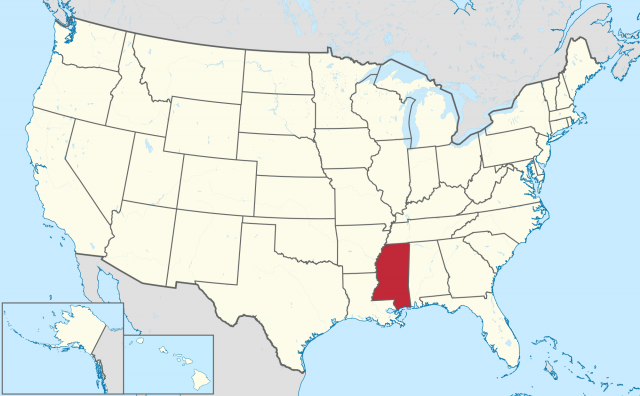Mississippi
KNOWN AS THE Magnolia State, Mississippi is bordered on the north by TENNESSEE, on the south by LOUISIANA and the Gulf of Mexico, on the east by ALABAMA, and on the west by lOUISIANA and ARKANSAS. The MISSISSIPPI RIVER, which flows along most of the western boundary of the state, is the origin of the state's name. Legend says the Mississippi was named by the Chippewa Indians who called it “Father of Waters.” Mississippi is proud of its antebellum history, and the state retains many vestiges of the Old South, including well-preserved plantations and Civil War reenactments.
The total area of Mississippi is 48,434 square mi (1,225,443 square km). The state ranks 32nd in size and 31st in population among the 50 states. Mississippi's largest cities are Jackson (the capital), Gulfport, Biloxi, Hattiesburg, Greenville, Meridian, Tupelo, Southaven, Vicksburg, and Pascagoula.

Approximately 1,520 square mi (3,936 km) of Mississippi are covered by water, and the coastline of the state runs 44 mi (113 square km) along the southern tip at the Gulf of Mexico. In addition to the Mississippi, the state's major rivers are the Big Black, the Pearl, and the Yazoo. Major Mississippi lakes, many of which have been created by damming river waters, include Ross Barnett Reservoir, Arkabutla Lake, Sardis Lake, and Grenada Lake. Over time, the Mississippi River, in its meanderings, has changed course, creating a number of oxbow lakes, such as Eagle Lake on the Mississippi-Louisiana border. The average elevation of Mississippi is 300 ft (91 m) above sea level. The highest point in the state is Woodall Mountain, which is only 800 ft above sea level. The lowest point in Mississippi is at sea level where the land meets the Gulf of Mexico. The state is approximately 340 mi (547 km) from north to south and approximately 170 mi (273 km) east to west.
The climate of Mississippi is moist and semitropical and the state is subject to severe afternoon thunderstorms, particularly from June through November, with most thunderstorms occurring in July. Mississippi has long, hot summers and short, mild winters. The average temperature ranges from the just above freezing in the winter to the mid-90s degrees F (low-30s degrees C) in the summer. Annual precipitation ranges from 50 in (127 cm) in the northwestern section of the state to 65 in (165 cm) in the southeastern region. While northern Mississippi occasionally sees snow, the phenomenon is rare in the rest of the state. Occasional hurricanes assail the state.
The land of Mississippi varies greatly from the deltas along the banks of the Mississippi and Yazoo rivers to coastal terraces, piney woods, and prairies, to the flatlands of Mississippi's highlands. Most of Mississippi falls within the East Gulf Coastal Plain, and the remaining area is encompassed within the Mississippi Alluvial Plain. In the East Gulf Coastal Plain, low hills predominate. The coastline of Mississippi is dotted by a number of large bays, including Bay Saint Louis, Biloxi, and Pascagoula. The relatively shallow Mississippi Sound divides the landmass from the Gulf of Mexico. The Mississippi Alluvial Plan, commonly referred to as the Delta, is relatively narrow but widens as it extends north toward Vicksburg. Much of the soil in the Delta has been enriched by the floodwaters of the Mississippi River.
Approximately 55 percent of Mississippi's land is forested. Northern forests are covered with hardwoods such as elm, hickory, oak, cedar, short leaf pine, and tupelo. Pines, such as loblolly longleaf, and slash, cover Mississippi's southern forests. Live oak, magnolia (the state tree), pecan, and sweet gum are found throughout the state. Flowering plants include magnolia (the state flower), azalea, black-eyed Susan, camellia, dogwood, iris, Cherokee rose, trillium, and violet. Large animals such as the white-tailed deer roam Mississippi's forests, which are also home to beaver, fox, opossum, rabbit, skunk, and squirrel. Mississippi is host to a number of songbirds, including the mockingbird (the state bird). The state has 29 state parks.
Until the beginning of the 20th century, Mississippi's economy was dominated by “King Cotton.” After 1907, when the boll weevil destroyed cotton as the mainstay in many states of the Old South, Mississippi farmers turned to other crops such as soybeans. Agriculture continued to support the state's economy until the middle of the 20th century, when manufacturing gained an edge. Mississippi continues to be highly rural, with approximately 40 percent of the state covered by farms. Farmers in the area continue to grow cotton, which is again the state's largest cash crop.
By the beginning of the 21st century, only Texas farmers produced more cotton than those in Mississippi. The state also produces rice, hay, corn, peanuts, sugar cane, sweet potatoes, and wheat. Mississippi leads the United States in the production of upholstered furniture. Other income-producing industries include chemicals, plastics, foods, and wood. The economy of Mississippi is also dependent upon large deposits of petroleum and natural gas. Mississippi is the world's leading producer of pond-raised catfish, and the seafood industry flourishes in coastal areas. Legal gambling in Biloxi also supplements the state's income.